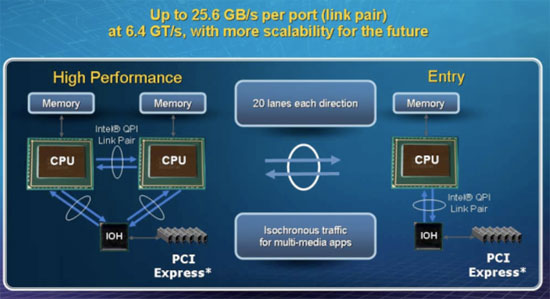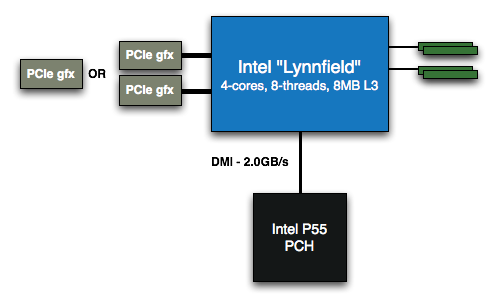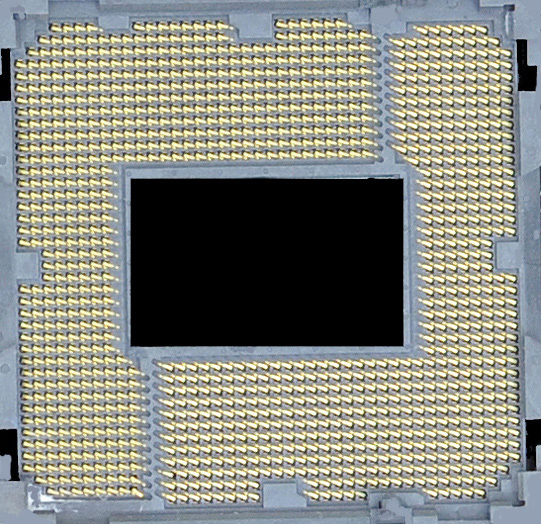The Lynnfield Preview: Rumblings of Revenge
by Anand Lal Shimpi on May 29, 2009 1:00 PM EST- Posted in
- CPUs
Making Nehalem Affordable: LGA-1156
Take the Core i7, shave off one memory controller and replace the high bandwidth QPI link with Intel’s slower DMI and you’ve got the makings of a (more) mainstream Nehalem.
Many have been calling this processor the Core i5 although I’m not quite ready to jump on that bandwagon, so I’ll keep referring to it by its socket (LGA-1156) or codename (Lynnfield).
Intel’s QPI is a very fast bus delivering up to 25.6GB/s of bandwidth. The image below shows you how Intel sees it being useful:

If you’ve got a multi-socket system (e.g. dual processor Xeon workstation, or Skulltrail successor) or if you’ve got a lot of high bandwidth PCIe devices (e.g. multi-GPU or lots of Larrabees) then QPI makes a whole lot of sense. However, if you’ve got a single socket system and aren’t running a lot of high bandwidth PCIe devices then QPI is overkill.
Intel’s DMI is the link used between the X58 chipset and the ICH10 I/O controller, it’s a much more conservative bus capable of delivering 2 - 4GB/s of bandwidth. That’s enough bandwidth for things like SATA and USB but a single PCIe x16 slot can deliver 16GB/s of bandwidth, far too much for Intel’s DMI.
Instead of crippling graphics on its mainstream platform, Intel did the next best thing and integrated 16 PCIe 2.0 lanes onto the die of its mainstream Nehalem part.
What you get looks like this:

A Lynnfield system only need two chips (CPU + PCH) while a Bloomfield system needs three (CPU + IOH + ICH)
The 16 PCIe 2.0 lanes can be configured as one x16 or two x8, allowing you enough bandwidth and very low latency to do things like CrossFire or SLI. Any additional PCIe lanes will branch off of what Intel is now calling the Platform Controller Hub (PCH). The first PCH is Intel’s P55 chipset; all you need is a Lynnfield CPU and the P55 PCH, no additional ICH is necessary as all of that functionality is embedded in the PCH.
The price of Intel’s P55 PCH is also much lower than the X58 chipset, in fact P55 is expected to be price competitive with P45 + ICH10. In other words, we should eventually see P55 boards priced at $100 or less.
Getting rid of QPI and one of the three DDR3 channels knocked down the pin-count of LGA-1366, but adding in 16 PCIe 2.0 lanes brought it back up to 1156 which you can count in the socket below:

I’ve blacked out the motherboard around it and the caps in the middle to protect the innocent.










95 Comments
View All Comments
Anand Lal Shimpi - Saturday, May 30, 2009 - link
P55 essentially has the same ICH feature set as P45. You get support for six SATA 3.0Gb/s ports, 12 USB 2.0 and PCIe 2.0.Intel's chipsets are actually what I use for all of my SSD tests and they work quite well. I wouldn't expect any different out of P55.
Remember that P55 is only the first Lynnfield chipsets, next year we'll see more. This chart speculates on some of the features of those (it also lists 14 USB instead of 12, I'm not sure which one is right):
http://img405.imageshack.us/img405/74/hkepcibexpea...">http://img405.imageshack.us/img405/74/hkepcibexpea...
Take care,
Anand
Drazick - Saturday, May 30, 2009 - link
I thought so...I hope someone will adopt the changes quickly.
It's about time to get rid of the BIOS and make room for speed improvements int the Flash chips (Both via the SATA 3 and USB 3).
Do you see in the horizon how long will it take before will see those features?
Thank you for the response.
Krogoth255 - Saturday, May 30, 2009 - link
I find it very funny when people make a huge fuss over a 2-10% difference in performance (i5 versus i7). It is sad that even budget CPUs are bloody overkill for majority of computer users.The bottom line is that i5 is going to be Intel's next big winner. It is the perfect Phenom II killer and an excellent successor to the Core 2 parts that it is replacing. I7 makes very little sense unless time is $$$$$.
PrinceGaz - Sunday, May 31, 2009 - link
Exactly. My nearly four-year old S939 Athlon 64 X2 still performs everything I do (with one exception) more than fast enough so the difference between the i5 and i7 would be irrelevant. I still think I'm at least a year or two from doing a new build (the only thing of any value at all in my current box I could reuse would be the graphics-card, a 640MB 8800GTS; most of the drives are parallel ATA, and the memory is of course DDR).Given that the one app where my current rig struggles is PCSX2 (a Playstation 2 emulator), it seems kind of silly to spend upwards of £500 for a new box simply to play PS2 console games, when I could probably buy a new PS2 console for under £100. Therefore debates over the relative merits of i5 and i7 which are both much faster are rather moot for me at the moment, and the vast majority of the PC buying public. It is nice to know how they compare though, and what their pros and cons are (the main con I see being the price of X58 mobos), so I'm thankful for this informative article on AT.
just4U - Saturday, May 30, 2009 - link
I don't quite understand why X58 boards are so expensive. At first we were complaining about ddr3 prices.. but they've come down to a managable point. While cheaper X58 solutions are starting to crop up it's still extremely high and I don't quite get why that is.With the memory controller integrated into the chip you'd think that the cost of the boards would be cheaper overall. That was one of Amd's main selling points (if I remember right) but for the i7 not the case.. the boards are priced incredibly high.
Anand Lal Shimpi - Saturday, May 30, 2009 - link
It's artificial. The boards are priced so high because Intel charges quite a bit of money for the X58 chipset. It's the cost of competition; if AMD had a true answer to i7 we'd have much more affordable i7 platforms all of the sudden :)Take care,
Anand
jmurbank - Sunday, May 31, 2009 - link
Chipset and processor prices are two different things. Neither are related to each other. Like all products, prices of chipsets is related to other chipsets competing at the same level. Since the X58 does not have any competitor, people have to pay a high premium for a complete i7 system. If nVidia is allowed to make a chipset for the i7 processor, we will see these high premium prices decrease. Since the i7 processor is designated as enthusiast setup, prices will still be at enthusiast pricing.just4U - Saturday, May 30, 2009 - link
You've had them on your test beds so you'd know better then I. Hell I haven't even gotten any hands on with the i7 since people here keep opting for the PII. Not that that's a bad thing, I am rather impressed with those overall just..Im beginning to realize the only way Im going to get my grubby little paws on a I7 is if I go out and build it for myself. Even I balk a little bit at the price tag of some of those boards but there are a few coming down the pipeline that look a little bit more reasonably priced.
Jabbernyx - Saturday, May 30, 2009 - link
EX58-UD3R = $150 from eWiz ;)goinginstyle - Saturday, May 30, 2009 - link
It is $185.99 at eWiz with a $15 rebate that will take two months to get for an end price of $170.99.